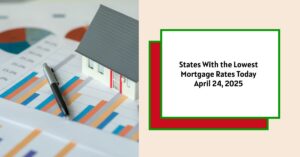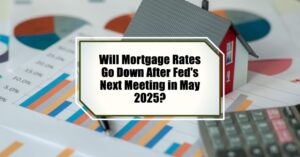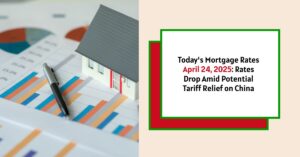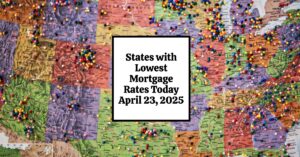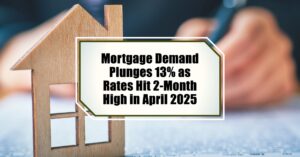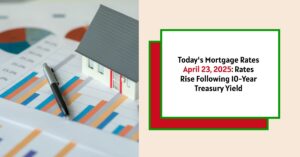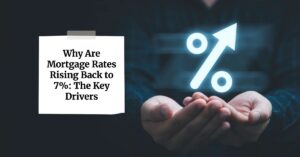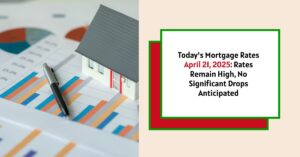Are you dreaming of owning a home but worried about sky-high mortgage rates? You're not alone! As of today, April 24, 2025, the states with the cheapest 30-year mortgage rates for new purchases are: New York, California, Pennsylvania, Florida, Massachusetts, Michigan, North Carolina, Ohio, Texas, and Washington. These states boast average rates hovering between 6.92% and 7.01%. Finding the lowest rates is a crucial first step towards turning your homeownership dreams into reality.
States With the Lowest Mortgage Rates Today – April 24, 2025
Why Mortgage Rates Matter – More Than Just a Number
I know, I know, mortgage rates might seem like just another boring number. But trust me, even a small difference in your interest rate can translate to thousands of dollars saved over the life of your loan. Think about it: that extra cash could go towards home improvements, your children's education, or even a well-deserved vacation. In simple terms, lower rates mean more money in your pocket! That's why it's so important to stay informed and shop around for the best deals.
The Top 10 States with the Lowest Mortgage Rates (April 24, 2025)
Here's a quick look at the states where you might find some relief in today's market:
- New York: Average rates between 6.92% and 7.01%
- California: Average rates between 6.92% and 7.01%
- Pennsylvania: Average rates between 6.92% and 7.01%
- Florida: Average rates between 6.92% and 7.01%
- Massachusetts: Average rates between 6.92% and 7.01%
- Michigan: Average rates between 6.92% and 7.01%
- North Carolina: Average rates between 6.92% and 7.01%
- Ohio: Average rates between 6.92% and 7.01%
- Texas: Average rates between 6.92% and 7.01%
- Washington: Average rates between 6.92% and 7.01%
On the Other End: States with Higher Rates
It's not all good news across the board. Some states are seeing significantly higher mortgage rates. As of today, Alaska, West Virginia, Utah, Kentucky, and Nevada along with Colorado and Indiana are experiencing the highest rates, ranging from 7.07% to 7.13%.
Why the Discrepancy? State-by-State Factors
You might be wondering, “Why are rates so different from state to state?” There are a few key factors at play.
- Lender Presence: Not all lenders operate in every state. The level of competition between lenders in your area can directly impact the rates they offer.
- Credit Scores: States with higher average credit scores may see slightly lower rates overall.
- Loan Sizes: The average size of a mortgage can influence rates, as larger loans may carry different risk profiles.
- State Regulations: Each state has its own set of regulations governing the mortgage industry. These regulations can impact lender costs and, ultimately, the rates they offer to borrowers.
National Mortgage Rate Trends: A Broader View
While it's important to focus on your state, understanding national trends can provide valuable context. Here's a snapshot of what's happening on a national level:
- 30-Year Fixed: The average rate for a 30-year fixed-rate mortgage fell slightly to 7.03% on Wednesday.
- Recent Fluctuations: Rates had been on the rise earlier in the month, hitting a high of 7.14%, but dipped back down recently. We can expect fluctuations in the future.
- Historical Context: Last month, rates dipped to a low of 6.50% and back in September, we saw a low of 5.89%. The highs and lows show the importance of timing and keeping an eye on the market.
To give you more insight, here's a quick table of the national averages of lender's best mortgage rates:
| Loan Type | New Purchase |
|---|---|
| 30-Year Fixed | 7.03% |
| FHA 30-Year Fixed | 7.37% |
| 15-Year Fixed | 6.13% |
| Jumbo 30-Year Fixed | 7.09% |
| 5/6 ARM | 7.46% |
Data by Zillow
Don't Fall for the “Teaser” Rate Trap
Be careful of super-low rates advertised online. These are often teaser rates designed to lure you in. They might require you to pay points upfront or be based on unrealistic borrower profiles (like someone with a perfect credit score and a tiny loan amount). The rate you actually qualify for will depend on your unique financial situation.
Key Factors That Affect Your Mortgage Rate
Remember, the rates you see quoted are just averages. Here's what lenders will consider when determining your rate:
- Credit Score: This is HUGE. The higher your credit score, the lower your rate will be.
- Income: Lenders want to see that you have a stable income and can comfortably afford your mortgage payments.
- Down Payment: A larger down payment typically results in a lower rate, as it reduces the lender's risk.
- Debt-to-Income Ratio (DTI): This compares your monthly debt payments to your gross monthly income. A lower DTI is generally better.
- Loan Type: Different loan types (e.g., fixed-rate, adjustable-rate, FHA, VA) come with different rates.
Read More:
States With the Lowest Mortgage Rates on April 23, 2025
When Will the Soaring Mortgage Rates Finally Go Down in 2025?
Mortgage Demand Plunges 13% as Rates Hit 2-Month High in April 2025
Why Are Mortgage Rates Rising Back to 7%: The Key Drivers
Understanding How Mortgage Rates Rise and Fall
Mortgage rates aren't just pulled out of thin air. They are influenced by a complex web of economic factors. Here are some key drivers:
- Bond Market: The yield on the 10-year Treasury bond is a major benchmark. When bond yields rise, mortgage rates tend to follow suit.
- Federal Reserve (The Fed): The Fed's monetary policy plays a big role. Actions like buying bonds or adjusting the federal funds rate can indirectly impact mortgage rates.
- Competition: The level of competition among mortgage lenders can also affect rates. More competition often leads to lower rates.
How to Secure the Best Rate
Okay, so what can you do to get the best possible mortgage rate? Here's my advice:
- Shop Around: Get quotes from multiple lenders! Don't settle for the first offer you receive.
- Improve Your Credit: Pay your bills on time, reduce your debt, and check your credit report for errors.
- Save for a Larger Down Payment: If possible, aim for a down payment of 20% or more.
- Consider Different Loan Types: Talk to a lender about the pros and cons of various loan options.
- Get Pre-Approved: Getting pre-approved for a mortgage gives you a clear idea of how much you can borrow and strengthens your negotiating power.
- Be Patient: Keep an eye on rate trends and be prepared to act when the time is right.
The Fed's Influence in 2025 – Still Playing a Role
The Federal Reserve's decisions continue to shape the mortgage market. After aggressively raising interest rates to combat inflation, the Fed began to make small rate cuts. However, future rate cuts are uncertain, and the Fed may hold rates steady for the time being. This means we can anticipate a state of flux in mortgage rates throughout the year.
Stay Informed, Stay Prepared
The mortgage market can be confusing, but with the right information, you can make smart decisions and achieve your homeownership goals. Don't be afraid to ask questions, do your research, and work with a trusted mortgage professional. Good luck!
Work With Norada, Your Trusted Source for
Real Estate Investment in the U.S.
Investing in turnkey real estate can help you secure consistent returns with fluctuating mortgage rates.
Expand your portfolio confidently, even in a shifting interest rate environment.
Speak with our expert investment counselors (No Obligation):
(800) 611-3060
Also Read:
- Will Mortgage Rates Go Down in 2025: Morgan Stanley's Forecast
- Expect High Mortgage Rates Until 2026: Fannie Mae's 2-Year Forecast
- Mortgage Rate Predictions 2025 from 4 Leading Housing Experts
- Mortgage Rates Forecast for the Next 3 Years: 2025 to 2027
- 30-Year Mortgage Rate Forecast for the Next 5 Years
- 15-Year Mortgage Rate Forecast for the Next 5 Years
- Why Are Mortgage Rates Going Up in 2025: Will Rates Drop?
- Why Are Mortgage Rates So High and Predictions for 2025
- Will Mortgage Rates Ever Be 3% Again in the Future?
- Mortgage Rates Predictions for Next 2 Years
- Mortgage Rate Predictions for Next 5 Years
- Mortgage Rate Predictions: Why 2% and 3% Rates are Out of Reach
- How Lower Mortgage Rates Can Save You Thousands?
- How to Get a Low Mortgage Interest Rate?
- Will Mortgage Rates Ever Be 4% Again?
